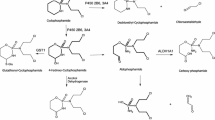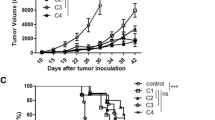Summary
Adult rats were given 105 or 106 Yoshida ascites sarcoma (YAS) cells IP and were treated with cyclophosphamide (CY) given IP in single doses of 20 mg/kg or 100 mg/kg, 2 or 5 days after YAS inoculation. Both the curative effect of CY and subsequent resistance to tumor challenge in rats that survived depended on the dose of injected tumor cells and on the dose and time of administration of CY. These three factors determined whether the host's immune response to tumor antigens would develop and contribute to the overall anti-tumor effects of the chemotherapy. The curative effects of CY were significantly less pronounced in T-cell-deficient than in normal rats. Anti-tumor and immunosuppressive activities of CY exerted opposite influences on the ultimate result of the chemotherapy. Adverse immunosuppressive effects prevailed when the drug was administered early (2 days) after YAS inoculation. In this case the chemotherapy was less efficient and the surviving rats were susceptible to a subsequent tumor challenge. Further analysis showed that the injection of CY 2 days after inoculation of YAS antigens induced strong and specific immunologic tolerance to the tumor. In contrast, when a sufficient amount of tumor antigens (higher dose of tumor cells injected and CY injection delayed) elicited an anti-YAS immune response that was not suppressed by early injection of CY (CY administered 5 days after the tumor) effective eradication of tumor cells and anti-YAS resistance in cured animals were observed.
Similar content being viewed by others
Abbreviations
- YAS:
-
Yoshida ascites sarcoma
- CY:
-
cyclophosphamide
- MRBC:
-
mouse red blood cells
References
Bremberg S (1970) The influence of host factors on cyclophosphamide treatment of Moloney virus-induced lymphomas. Eur J Cancer 6:277
Boyle W (1968) An extension of 51Cr-release assay for estimation of mouse cytoxins. Transplantation 6:761
Chassoux DM, Gotch FM, MacLennan ICM (1978) Analysis of synergy between cyclophosphamide therapy and immunity against a mouse tumour. Br J Cancer 38:211
Čulo F, Allegretti N, Marušić M (1977) Lymphotoxic effect of cyclophosphamide in therapy of Ehrlich ascites carcinoma in mice. J Natl Cancer Inst 58:1759
De Wyss WD (1972) A quantitative model for the study of the growth and treatment of a tumor and its metastases with correlation between proliferative state and sensitivity to cyclophosphamide. Cancer Res 32:367
De Wyss WD, Goldin A, Mantel N (1970) Hematopoietic recovery after large doses of cyclophosphamide: Correlation of proliferative state with sensitivity. Cancer Res 30:1692
Dunham JL, Stewart HL (1953) A survey of transplantable and transmissible animal tumors. J Natl Cancer Inst 13:1299
Hengst JCD, Mokyr MB, Dray S (1980) Importance of timing in cyclophosphamide therapy of MOPC-314 tumor-bearing mice. Cancer Res 40:2135
Lausch RN, Ross SE, Rapp F (1972) Effect of cyclophosphamide on syngeneic transplantation of para-adenovirus-7-transformed tumor cells in hamster. Int J Cancer 9:659
Lubet RA, Carlson ED (1977) Tumor immunity directed against MOPC 104E: Effect of various therapeutic regimens. Cancer Immunol Immunother 2:267
Lubet RA, Carlson DE (1978) Therapy of the murine plasmacytoma MOPC 104E: Role of the immune response. J Natl Cancer Inst 61:897
Marušić M, Allegretti N, Čulo F (1978) The timing of cyclophosphamide therapy in tumor-bearing rats affects the resistance to tumor challenge in survivors. Experientia 34:1355
Mathé G, Halle-Pannenko O, Bourut C (1977) Effectiveness of murine leukemia chemotherapy according to the immune state. Reconsideration of correlations between chemotherapy, tumor cell killing and survival time. Cancer Immunol Immunother 2:139
Miller JFAP (1960) Studies on mouse leukaemia. The role of the thymus in leukaemogenesis by cell-free leukaemic filtrates. Br J Cancer 14:93
Moore M, Williams DE (1973) Contribution of host immunity to cyclophosphamide therapy of a chemically-induced murine sarcoma. Int J Cancer 11:358
Santos GW (1972) Application of marrow grafts in human disease: Its problems and potential. In: Hanna MG (ed) Current problems in immunobiology. Plenum, New York, p 143
Sugiura K, Schmid FA, Schmid MM (1961) Antitumor activity of Cytoxan. Cancer Res 21:1412
Author information
Authors and Affiliations
Rights and permissions
About this article
Cite this article
Vidović, D., Marušić, M. & Čulo, F. Interference of anti-tumor and immunosuppressive effects of cyclophosphamide in tumor-bearing rats. Cancer Immunol Immunother 14, 36–40 (1982). https://doi.org/10.1007/BF00199430
Received:
Accepted:
Issue Date:
DOI: https://doi.org/10.1007/BF00199430




